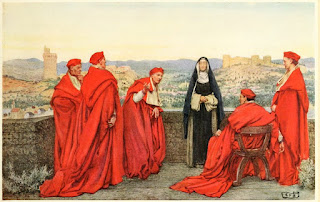It was not to be, however: King John of England came looking for a wife who could give him heirs, which was not going to happen with his first wife, Isabella of Gloucester. He settled on Isabella of Angoulême, annulled his first marriage, and married for the second time on 24 August 1200.
Isabella was still a child, and John treated her carefully, so it was not until 1 October 1207 when she was about 20 years old that she gave birth to a son and heir, who would become Henry III. She bore John a total of five children.
Henry was nine when John died, and Isabella swiftly arranged to have him crowned king. Unfortunately, John had lost his crown and much of his treasury, so she provided her own queen's circlet as part of the ceremony. By this time, she was already Countess of Angoulême (her father had died in 1202), so a year after the coronation, she left Henry in the care of his regent, William Marshal, and went to her lands in Angoulême.
In an interesting parallel, her daughter Joan (born 1210) was being raised in the Lusignan court and had been betrothed to Hugh X of Lusignan, son of the man to whom Isabella was originally betrothed. Hugh, however, seeing that Isabella's beauty had not diminished (she was only in her 30s), proposed to the woman who had long ago been promised to his father. They were wed in the spring of 1220. A different marriage was arranged for Joan.
As it turns out, the king's council in England reserved to itself the power to determine whether and to whom a queen dowager should marry; after all, she held lands due to her dead husband, and had a pension from the council. They objected to her marriage to Hugh that was done without their consent, so they canceled her pension and confiscated her English possessions. They wrote to the pope, asking for her to be excommunicated, but ultimately decided to negotiate with her for a swifter conclusion, because Isabella was keeping Joan with her, preventing the alternate marriage that was arranged to the King of Scotland. The council decided to allow her some financial support, like the stannaries in Devon.
Isabella had a difficult time adjusting to life as less than a queen. She and her husband tried uniting some of the French nobles against Louis IX. She encouraged Henry III when he invaded Normandy in 1230 (but could not provide him any military support). An attempt to poison King Louis IX by two cooks was foiled in 1244, but the cooks admitted they were paid by Isabella. She fled to Fontevrault Abbey for sanctuary ahead of the king's men, where she died on 4 June 1246. She was buried outside the abbey. Henry III visited the abbey later and objected to her burial outside. He had her moved inside, near Henry II and Eleanor of Aquitaine.
All of her children—five with John, nine with Hugh—survived to adulthood and had titles and good careers, any of whom would be interesting to look at next. I think, however, the "stannaries in Devon" wants explanation, and will be a nice respite from political marriages. See you next time.



























